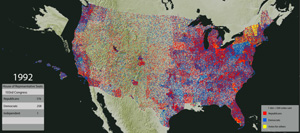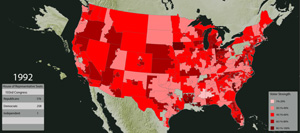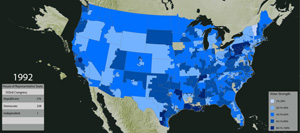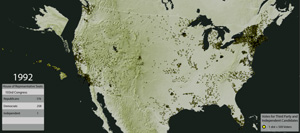Congressional Elections
Dot Density Voting in Congressional Elections, 1992 - 2008:
Dot density maps emphasize the number of votes in a given area and encourage the viewer to consider the strength of minority parties and the relative populations and voting power of places as different as North Dakota is from a congressional district in Los Angeles. They provide a helpful corrective to maps (such as those showing only the winner in a district) that represent only the votes representing the winning candidate.
District winner in Congressional Elections, 1992 - 2008:
This map dramatizes the shifts back and forth from a blue trending nation to one trending red during the 1990s and 2000s. The winning party in each district is represented in this map.
Republican Strength in Congressional Elections, 1992 - 2008:
Where have Republicans been especially strong in Congressional elections? These maps show the relatively consistent Republican strength in much of the South and Midwest in Congressional elections and the relative weakness of GOP candidates in much of New England. Districts in which the Republican party did not field a candidate are represented without shading.
Democratic Strength in Congressional Elections, 1992 - 2008:
These animations show the inverse of maps of Republican strength in Congressional elections, 1992-2008. Districts in which the Democratic party did not field a candidate are represented without shading. Those in which Democrats ran unopposed are represented in deep blue, even if votes were not officially tabulated in these races.
Votes for third-party and independent candidates in Congressional Elections, 1992 - 2008:
Third party and independent candidates have often made inroads in US politics, despite the fact that we often consider American politics to be a binary, red/blue, Republican/Democrat. Consistent votes for third party candidates are a reminder that even an extremely stable two-party system involves consistent voting for alternative candidates, a dynamic that may help to provide that system its strength.





